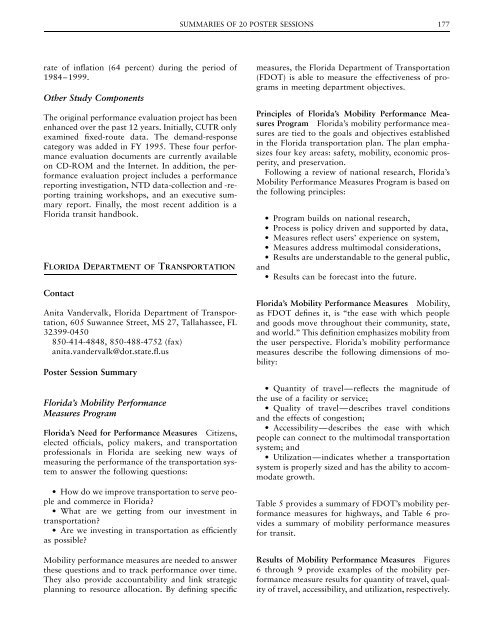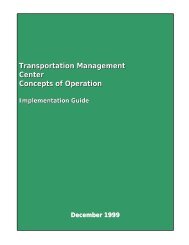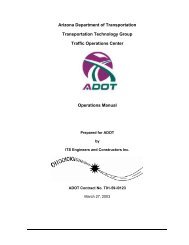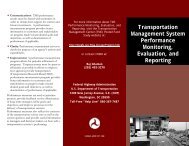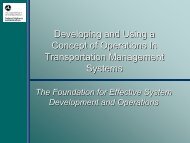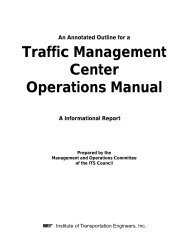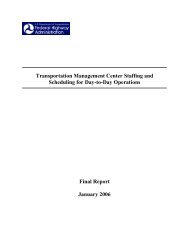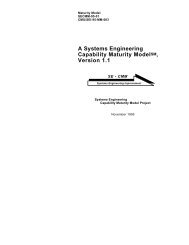Conference Proceedings 26 - Transportation Research Board
Conference Proceedings 26 - Transportation Research Board
Conference Proceedings 26 - Transportation Research Board
- No tags were found...
Create successful ePaper yourself
Turn your PDF publications into a flip-book with our unique Google optimized e-Paper software.
SUMMARIES OF 20 POSTER SESSIONS 177rate of inflation (64 percent) during the period of1984–1999.Other Study ComponentsThe original performance evaluation project has beenenhanced over the past 12 years. Initially, CUTR onlyexamined fixed-route data. The demand-responsecategory was added in FY 1995. These four performanceevaluation documents are currently availableon CD-ROM and the Internet. In addition, the performanceevaluation project includes a performancereporting investigation, NTD data-collection and -reportingtraining workshops, and an executive summaryreport. Finally, the most recent addition is aFlorida transit handbook.FLORIDA DEPARTMENT OF TRANSPORTATIONContactAnita Vandervalk, Florida Department of <strong>Transportation</strong>,605 Suwannee Street, MS 27, Tallahassee, FL32399-0450850-414-4848, 850-488-4752 (fax)anita.vandervalk@dot.state.fl.usPoster Session SummaryFlorida’s Mobility PerformanceMeasures ProgramFlorida’s Need for Performance Measures Citizens,elected officials, policy makers, and transportationprofessionals in Florida are seeking new ways ofmeasuring the performance of the transportation systemto answer the following questions:• How do we improve transportation to serve peopleand commerce in Florida?• What are we getting from our investment intransportation?• Are we investing in transportation as efficientlyas possible?Mobility performance measures are needed to answerthese questions and to track performance over time.They also provide accountability and link strategicplanning to resource allocation. By defining specificmeasures, the Florida Department of <strong>Transportation</strong>(FDOT) is able to measure the effectiveness of programsin meeting department objectives.Principles of Florida’s Mobility Performance MeasuresProgram Florida’s mobility performance measuresare tied to the goals and objectives establishedin the Florida transportation plan. The plan emphasizesfour key areas: safety, mobility, economic prosperity,and preservation.Following a review of national research, Florida’sMobility Performance Measures Program is based onthe following principles:• Program builds on national research,• Process is policy driven and supported by data,• Measures reflect users’ experience on system,• Measures address multimodal considerations,• Results are understandable to the general public,and• Results can be forecast into the future.Florida’s Mobility Performance Measures Mobility,as FDOT defines it, is ‘‘the ease with which peopleand goods move throughout their community, state,and world.’’ This definition emphasizes mobility fromthe user perspective. Florida’s mobility performancemeasures describe the following dimensions of mobility:• Quantity of travel—reflects the magnitude ofthe use of a facility or service;• Quality of travel—describes travel conditionsand the effects of congestion;• Accessibility—describes the ease with whichpeople can connect to the multimodal transportationsystem; and• Utilization—indicates whether a transportationsystem is properly sized and has the ability to accommodategrowth.Table 5 provides a summary of FDOT’s mobility performancemeasures for highways, and Table 6 providesa summary of mobility performance measuresfor transit.Results of Mobility Performance Measures Figures6 through 9 provide examples of the mobility performancemeasure results for quantity of travel, qualityof travel, accessibility, and utilization, respectively.


